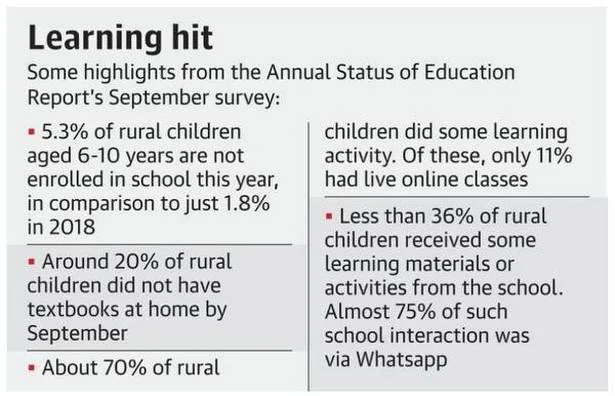Governance
ASER Survey 2020
- 29 Oct 2020
- 7 min read
Why in News
Recently, the Annual State of Education Report (ASER) survey has been released which provides a glimpse into the levels of learning loss that students in rural India are suffering, with varying levels of access to technology, school and family resources resulting in a digital divide in education.
- This year, in the wake of the pandemic, the survey was conducted via phone calls, reaching 52,227 rural households with school-age children in 30 States and Union Territories (UTs).
Annual Status of Education Report
- It is a nationwide survey of rural education and learning outcomes in terms of reading and arithmetic skills that has been conducted by the NGO Pratham for the last 15 years.
- It uses Census 2011 as the sampling frame and continues to be an important national source of information about children’s foundational skills across the country.
- ASER 2018 surveyed children in the age group of 3 to 16 years and included almost all rural districts in India and generated estimates of foundational reading and arithmetic abilities of children in the age group 5 to 16 years.
- ASER 2019 reported on the pre-schooling or schooling status of children in the age group 4 to 8 years in 26 rural districts, focused on the “early years” and laid emphasis on “developing problem-solving faculties and building a memory of children, and not content knowledge”.
- ASER 2020 is the first ever phone-based ASER survey and it was conducted in September 2020, the sixth month of national school closures.
Key Points
- Enrollments:
- 5.5% of rural children are not currently enrolled for the 2020 school year, up from 4% in 2018.
- This difference is the sharpest among the youngest children (6 to 10) where 5.3% of rural children had not yet enrolled in school in 2020, in comparison to just 1.8% in 2018.
- Due to the disruptions caused by the pandemic, families are waiting for the physical opening of schools to enrol their youngest children, with about 10% of six-year-olds not in school.
- Among 15-16 year-olds, however, enrollment levels are slightly higher than in 2018.
- The proportion of boys enrolled in government schools has risen from 62.8% in 2018 to 66.4% in 2020, while for girls, that number has gone up from 70% to 73% in the corresponding period.
- Patterns show a slight shift toward government schools, with private schools seeing a drop in enrolment in all age groups.
- The Centre has now permitted States to start reopening schools if they can follow Covid-19 safety protocols but the majority of the country’s 25 crore students are still at home.
- 5.5% of rural children are not currently enrolled for the 2020 school year, up from 4% in 2018.
- Availability of Smartphones:
- Among enrolled children, 61.8% live in families that own at least one smartphone which was merely 36.5% in 2018.
- About 11% of families bought a new phone after the lockdown, of which 80% were smartphones.
- WhatsApp is by far the most popular mode of transmitting learning materials to students, with 75% of students receiving input via this app.
- Among enrolled children, 61.8% live in families that own at least one smartphone which was merely 36.5% in 2018.
- Availability of Learning Material:
- Overall more than 80% of children said they had textbooks for their current grade.
- This proportion was higher among students enrolled in government schools (84.1%) than in private ones (72.2%).
- In Bihar, less than 8% got such materials from their schools, along with 20% in West Bengal, Rajasthan and Uttar Pradesh.
- More than 80% of rural children in Himachal Pradesh, Punjab, Kerala and Gujarat received such input.
- Overall more than 80% of children said they had textbooks for their current grade.
- Learning Activities:
- Most children (70.2%) did some form of a learning activity through material shared by tutors or family members themselves, with or without regular input.
- 11% had access to live online classes, and 21% had videos or recorded classes, with much higher levels in private schools.
- About 60% studied from their textbooks and 20% watched classes broadcast on TV.
Suggestions
- Fluid Situation: When schools reopen, it will be important to continue to monitor who goes back to school as well as to understand whether there is learning loss as compared to previous years.
- Building on and Strengthening Family Support: Parents’ increasing levels of education can be integrated into planning for learning improvement, as advocated by National Education Policy, 2020. Reaching parents at the right level is essential to understand how they can help their children and older siblings also play an important role.
- Hybrid Learning: As children do a variety of different activities at home, effective ways of hybrid learning need to be developed which combine traditional teaching-learning with newer ways of “reaching-learning”.
- Assessment of Digital Modes and Content: In order to improve digital content and delivery for the future, an in-depth assessment of what works, how well it works, who it reaches, and who it excludes is needed.
- Mediating the Digital Divide: Children from families who had low education and also did not have resources like smartphones had less access to learning opportunities. However, even among such households, there is evidence of effort with family members trying to help and schools trying to reach them. These children will need even more help than others when schools reopen.
Way Forward
- Covid-19 has left the nation with deep economic distress and uncertainty over school-reopenings and thrown open new challenges in every sector.
- The nationally representative sample highlighted the role played by the families where everyone in the family supported children regardless of their education levels.
- This strength needs to be leveraged by reaching out to more students and reducing the distance between schools and homes.






